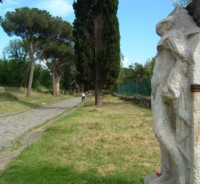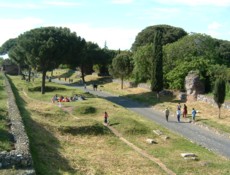The Via Appia Antica is the old Roman Appian Way, which ran from Rome down to Brindisi. The stretch close to Rome, the Via Appia Antica, is now part of an nature and archaeological park, the Parco Regionale dell’Appia Antica, and makes a lovely day out, particularly on Sundays when the area is closed to traffic.

It’s possible to walk a very long way along the old stretch of road, so it’s a good idea to collect a map from the Visitor Centre at the very beginning of the road (Via Appia Antica 42) and get an idea of public transport options – or leave yourself enough time and energy to retrace your steps.
The beginning of the road, outside the Porta San Sebastiano, a gate in the city walls, is lined with interesting dilapidated buildings, including the church of Domine Quo Vadis, where St. Peter is supposed to have had a vision of Christ. Jesus’s footprints were preserved for posterity in a slab of white marble (in the centre of the church floor). There are also three sets of catacombs close to this stretch of road – check opening times and days first as their long lunchtime closures can interfere with your day’s planning.
To get the best from your excursion, be prepared for a long walk and don’t forget to take water to drink (there are taps where you can refill your bottle). Take bus 218 from San Giovanni (it departs from the shady bus stops opposite the green lawns in front of the basilica) or 118 from Piramide (outside the Metro station). Get off at the start of the Via Appia Antica, at the first or second stop outside the Aurelian Wall and Porta San Sebastiano. On your right is the Visitor Centre where you can pick up maps and leaflets about the area, and even hire bicycles. Follow the road around to the left, past the church of Domine Quo Vadis. You can take a detour from this point to visit the Valley of the Caffarella. Otherwise simply follow the road as far as you wish.

After the catacombs you’ll see the Circus of Maxentius (which is much better-preserved than the Circus Maximus) and the Tomb of Cecilia Metella, a round mausoleum later converted into a fortress. These are two of the finest sites on the road, but for the most atmospheric stretch of the walk, continue onwards for a mile or two.
Just after the Tomb of Cecilia Metella there is a small cafe-bar with a garden where you can stop for food and drink. Bus 660 runs from the junction here to the Metro at Colli Albani, if you’re feeling tired.
As the road continues, you begin to see stretches of ancient paving stones, and the smart villas lining the road give way to fields. Ruins dot the verges: some well-preserved and others just piles of stone. Carved marble records the Roman nobility who had their mausoleums placed here, to be marvelled at by long-ago travellers. The tourists thin out as you press onwards, and the landscape becomes wilder and more marvellous.
Ruins along this stretch of road include the Villa of the Quintili, a grand villa which was requisitioned by the Emperor Commodus (the entrance is the far side, on the main road). There are also a couple of vast round mausoleums.
To return to the city centre using public transport, turn left after the round mausoleum with a house on top (a notable sight) and the railway line. A short but nasty (no pavement) walk along Via Casal Rotondo takes you to the noisy Via Appia Nuova. Cross at the traffic lights and wait at the stop opposite for the 664 to Colli Albani, where you can take the Metro.
Walking along the Via Appia Antica is a refreshing outing after time spent in the city. The road is attractive and atmospheric, with plenty of grassy spots where you can picnic. One Sunday we even came across a cricket match being played in a field, to the puzzlement of Italian passers-by. You can walk a very long way without getting bored – the furthest we have managed is the ring road, close to Ciampino Airport. Note though, that towards dusk the atmosphere gets decidedly seedy. Prostitutes appear from nowhere and settle at the roadside, while leering old men cruise up and down in their battered cars. Especially for women, it’s best to stick to the daylight hours when visiting the road.
On this site
Caffarella Archaeological Park
Useful external links